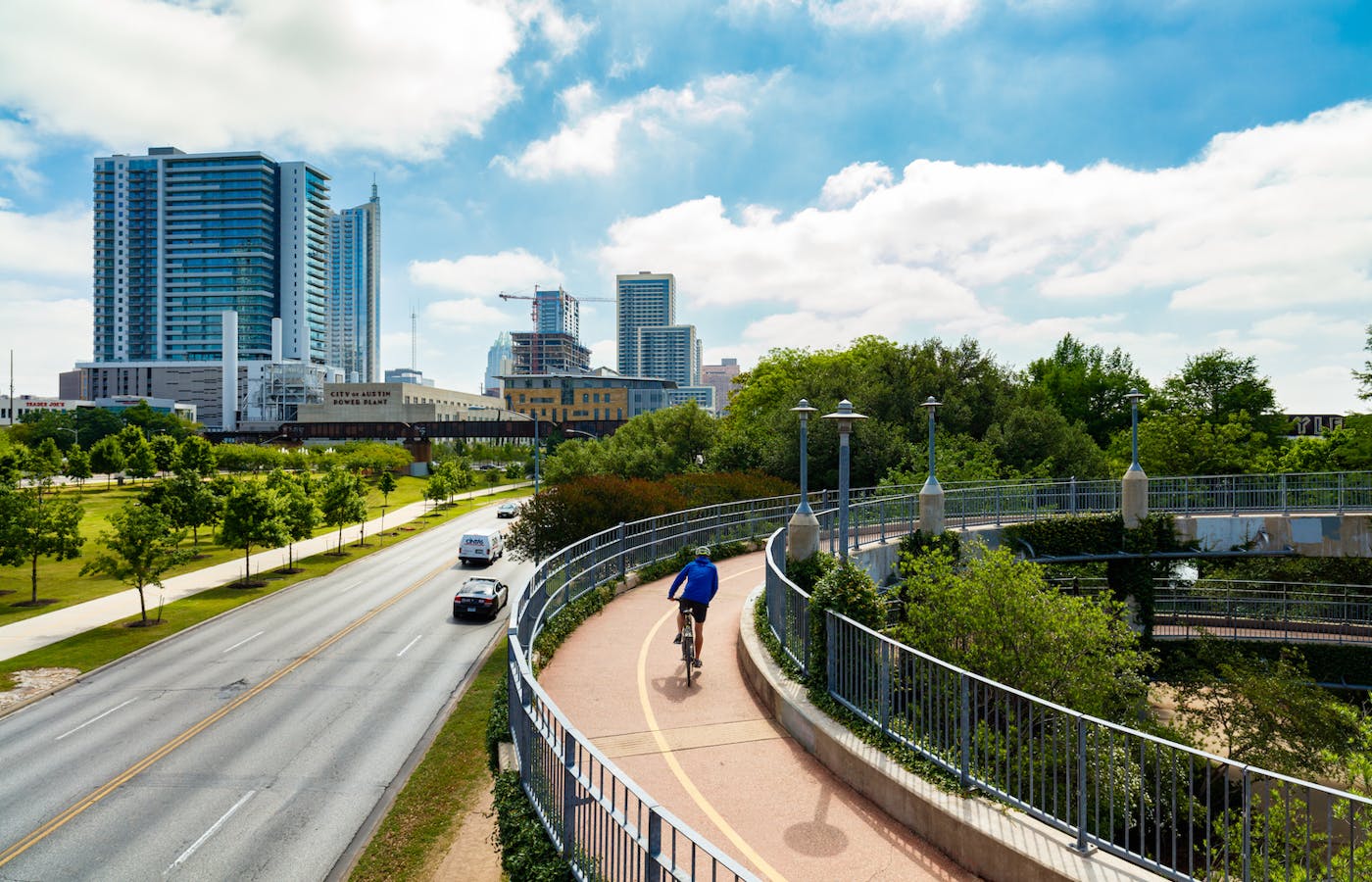A Tale of Two Biking Cities
By: Jack Foersterling, PeopleForBikes’ copywriter and editor

Austin, Texas, and Paris, France, both made big commitments to prioritize bicycling. But how do the cities’ efforts compare?
When people talk about great bicycling cities, places like Copenhagen and Amsterdam usually lead the conversation, perhaps followed by Portland or San Francisco if you’re focused on biking in the U.S. While these lofty reputations are thanks to a myriad of work done by each of these cities over many years, one underlying similarity links many of the world’s best places to ride a bike: a dedicated, concerted investment in infrastructure that gets people where they need to go, safely and conveniently, without needing to get behind the wheel of a car.
Two cities — Austin, Texas, and Paris, France — both recently made such commitments to prioritize bicycling — connecting communities, relieving traffic congestion, improving air quality and fostering healthier residents along the way.
Paris’ journey began in 2014 under their newly elected Mayor Anne Hidalgo. In an effort to curb the city’s growing car traffic problems and make Paris a global cycling capital, Mayor Hidalgo’s “Plan Velo” was an aggressive, $167 million bicycle infrastructure program that promised to build 1,400 kilometers (~870 miles) of cycleways by 2020, essentially doubling the size of the bike network at the time.
Also in 2014, Austin, Texas, set a similarly ambitious goal: Build a 400-mile bicycle network that winds throughout the city, connecting urban trails, quiet neighborhood streets and new protected bike lanes. The envisioned “All Ages and Abilities Bicycle Network” would be accompanied by other infrastructure updates, with the end goal of improving mobility and creating a more livable community for all Austin residents.
“We have to do a better job of giving everyone in our city more equitable, safer and convenient transportation choices,” said Mayor Adler in a 2021 interview with PeopleForBikes. “People of all ages — whether they’re a child or in their eighties — and of all backgrounds have to feel comfortable and secure moving freely in Austin.”
Paris managed to build 1,000 of their planned 1,400-kilometers of cycleways by 2020, increasing bicycle use in the city by 54%, but Austin’s network rollout wasn’t as immediately successful. The city had constructed less than 20 miles of their envisioned network by the end of 2017, a pace that meant the project wouldn’t likely be completed for decades.
Thanks to the efforts of MoveATX, a coalition of community leaders, advocates, activists and local organizations, buoyed by the work of the PeopleForBikes Final Mile project, which sought to accelerate the construction of bike networks in five U.S. cities, Austin sped up the pace of construction, building more than 100 miles of new bikeways between 2019 and June of 2021. This accelerated progress brought the All Ages and Abilities Network to 215 miles, more than half of the envisioned miles in the 2014 plan.
While Paris’ initial success outweighs Austin’s by more than 400 more miles of bikeways built in the same timeframe, there are still lessons to be learned from the Texas Capital. The fact that Austin is only one of few North American cities to reach such a milestone while Paris is following in the footsteps of its bicycle-famous neighbors in Denmark, the Netherlands and Belgium shows Austin’s commitment to leading the way on building better bicycling infrastructure in the U.S. This network transformation taking place in its home state of Texas, known for its highways, big trucks and even bigger car-centric attitude, only doubles down on Austin’s dedication to bucking the norm and taking proactive steps that benefit everyone, not just those who drive.
Outside of their network achievements, the physical size and density of Paris and Austin also makes them an interesting comparison. Austin’s population of just over 1 million resides on 272 square miles where Paris’ 2 million residents are squeezed into just 41 square miles, making Austin seven times larger than its French counterpart with half of the population. 64% of Austin residents currently being able to access the All Ages and Abilities Network show’s the city’s ongoing dedication to making sure infrastructure improvements aren’t solely tied to busy city centers.
Looking ahead, both Austin and Paris show no signs of slowing down. After re-election in 2020, Mayor Hidalgo announced “Act 2” of her Plan Velo, with $290 million in funding dedicated for cycling improvements through 2026. Beyond bike lanes, the additional plans also include removing more than 100,000 on-street parking spaces and limiting vehicle traffic across the city, taking street space back from cars and allowing more room for bike lanes, bike parking, green spaces and other public amenities.
Thanks to overwhelming voter support for Proposition B in November 2020, Austin passed a $460 million active transportation bond meant to continue the expansion of walking and biking networks throughout the city. $40 million will be directly funding additional miles for the AAA network, of which City of Austin officials expect to pass more than 400 total miles (more than 100% of the original miles envisioned in 2014) by 2025. Once complete, Austin expects 83% of residents to be able to easily walk, bike or scoot using the AAA network throughout the city.
Depending on what metrics you look at, weighing the work of Austin and Paris may seem like comparing apples and oranges. But the common thread that unites the efforts of these capital cities located thousands of miles apart is this: Both cities are not historically known for cycling. But thanks to the strong political will of elected officials combined with existing public support for bicycling, both Paris and Austin made a decision — to prioritize bicycling in order to make their city a better place to live. Cycling utopias aren’t built in a day, but by laying the groundwork to position bicycling as a safe, healthy and easy way to get around, Austin and Paris may soon see themselves amongst the Copenhagens and Amsterdams of the world.
Learn more about Austin and the Final Mile by visiting finalmile.peopleforbikes.org.

